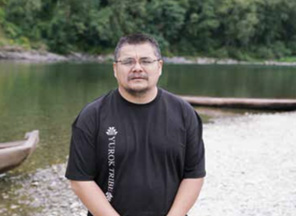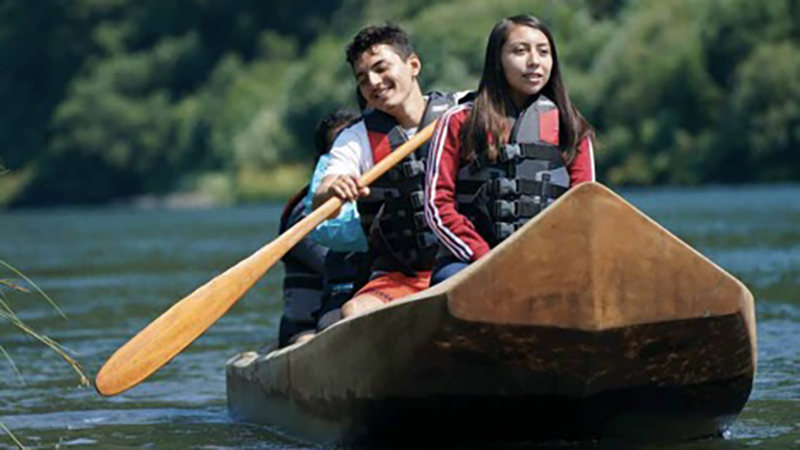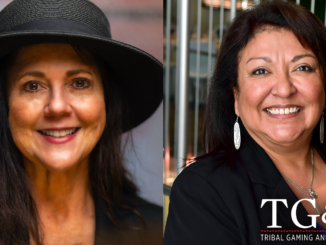The Yurok Tribe’s enviable location amidst the California Redwoods sets the stage for incomparable hospitality experiences.
In Yurok country, everything is so big, it’s not difficult to picture yourself in the center of the world. Ancient Redwood giants point to the sky with great round trunks of unimaginable diameters, so tall that large trees grow underneath them, and smaller trees underneath those trees. Large swaths of ferns unfurl and cover the high walls of foggy creeks and canyons stretching father than the eye can see.
These Redwood trees are so old that they may still remember what it feels like to have a Grizzly Bear rub up against their fibrous bark. Yet, in silent solidarity they remain, standing with their original caretakers, the Yurok people. The lushness of this landscape is fed by the massive waters of the Klamath River, just before it empties into the sea, the culmination of a journey that feeds 5.6 million acres of river basin on its way home to the Pacific Ocean, passing through Yurok country at the finish line.
The Yurok people, like the land they steward, are doing big things.
With the completion of the Redwood Hotel and Casino in Klamath, the Yurok Tribe immediately set plans in motion to increase tourism opportunities for adventurers looking for an outdoor experience not found anywhere else on Earth. With a laser focus on improving ecological tourism, they have built a unique piece of cultural education into their strategy, amplifying the voices of the Yurok people and the land itself.
In 2014, after the opening of the hotel and casino, the Yurok Country Visitor Center was constructed as an informational hub offering travelers an opportunity to discover the Yurok Scenic Byways — five, Tribally-designated roads within Yurok ancestral territory. They then purchased the Klamath Jet Boat Tours and adjacent RV Park in 2015, touting a 50-mile guided trip up the river where guests are treated to local wildlife sightings and a bit of adventure right on the Klamath River.
But Yurok Country is vast and so are their plans, including an important historic agreement between the Yurok Tribe and California State Parks to operate the Stone Lagoon Visitor’s Center, located 30 miles south of Klamath and 30 miles north of Arcata. The Tribe recently renamed the facility Chah-pekw O’ Ket’-toh (Stone Lagoon) Visitor Center.
“Yurok people have been holding ceremonies and dances at Chah-pekw O’ Ket’oh (Stone Lagoon) since time immemorial,” says Rosie Clayburn, who is the Tribal Heritage Preservation Officer for the Tribe. She also notes that the Yurok village site has been in continual use for millennia and the Tribe’s traditional Jump Dance is still being performed there.
Making Connections; Making History

– Joseph L James Yurok Tribal Chairman
This government-to-government agreement between the Tribe and the park is the first of its kind in California and comes with joint powers of authority. “It is the highest power of classification of agreement that I could enter into,” said Victor Bjelejac, North Coast Redwoods District Superintendent. “Nobody has ever done this before.”
In preparation for opening, Rosie oversees a renovation of the Visitor’s Center that will include multimedia displays, exhibits and interpretive staff who will greet visitors and share the Tribe’s story in its own words. They will also offer basket weaving classes, traditional story-telling events and kayaking on the lagoon.
This historic partnership between the Yurok Tribe and Bjelejac doesn’t stop with Chah-pekw O’ Ket’oh, it has also extended into Sumêg Village (Patrick’s Point State Park) where gatherers have previously struggled with access to their traditional gathering places due to conflicts with State Park personnel. Now the park has interpreters on-site, and tribal citizens are able to come and gather more freely.
Along with these historic partnerships, the Yurok Tribe is making history in other ways as well. They recently acquired the Mad River Brewing Company, a craft brewery located in Blue Lake, a few miles east of Arcata.
Linda Cooley, COO of the Mad River Brewing Company, is overseeing exciting developments, including the revitalization of an intertribal-trade opportunity with the San Manuel Band of Mission Indians Casino in southern California, east of Los Angeles. This partnership will bring in vital resources for the Yurok people in regard to economic development, and as with all of their endeavors, environmental sustainability will be a cornerstone component of the brewery’s growth strategy. The site itself is a thriving local taproom, and fans of the classic Steelhead Ale can be found all over the world. Linda also has plans to have the Tribe begin growing their own hops while expanding the reach of potential partnerships with other tribes.
Looking Out for Future Generations
Also on the Klamath River, a project near and dear to Yurok Tribal Chairman Joseph L. James’ heart, is the Redwood Yurok Canoe Tours. Showcasing the unique boatbuilding talents of the Yurok people, these redwood dugout canoes are meticulously handcrafted and helmed by two Yurok guide captains narrating a river experience full of wildlife and historical sites, while guests glide up and down the Klamath River as the Yurok people have done for thousands of years.
“We received an incredible response when we first announced the canoe tours—more people are visiting national parks, and we’re seeing that here as well,” said Chairman James. Chairman James believes that singular cultural experiences like the canoe tours will be a draw for international travelers and adventurers alike.
The Yurok Tribe has even more intriguing projects in the works. One of them isn’t about tourism numbers, but rather bringing home some cherished relatives, the California Condors. The Tribe’s condor release program recently completed the final environmental review, and the Tribe will soon begin building a release facility on a previously selected site.
The Tribe proposed this historic endeavor and built the program from the ground up. Over the course of a decade the Yurok Wildlife Department team conducted all of the scientific studies and completed the multitude of requisite tasks associated with reintroducing a critically endangered species. Returning prey-go-neesh (condor) to their homeland is an opportunity to reconnect a piece of an ecosystem that has been missing for more than a century. With tall trees, wide wingspans and a vast river system, the most populous Tribe in California is laying the foundation for a truly world-class, culturally centered tourism experience.
Article by Sara Calvosa Olson, AIANTA
The American Indian Alaska Native Tourism Association’s Cultural Heritage Planner
To learn more about AIANTA, visit https://www.aianta.org/




